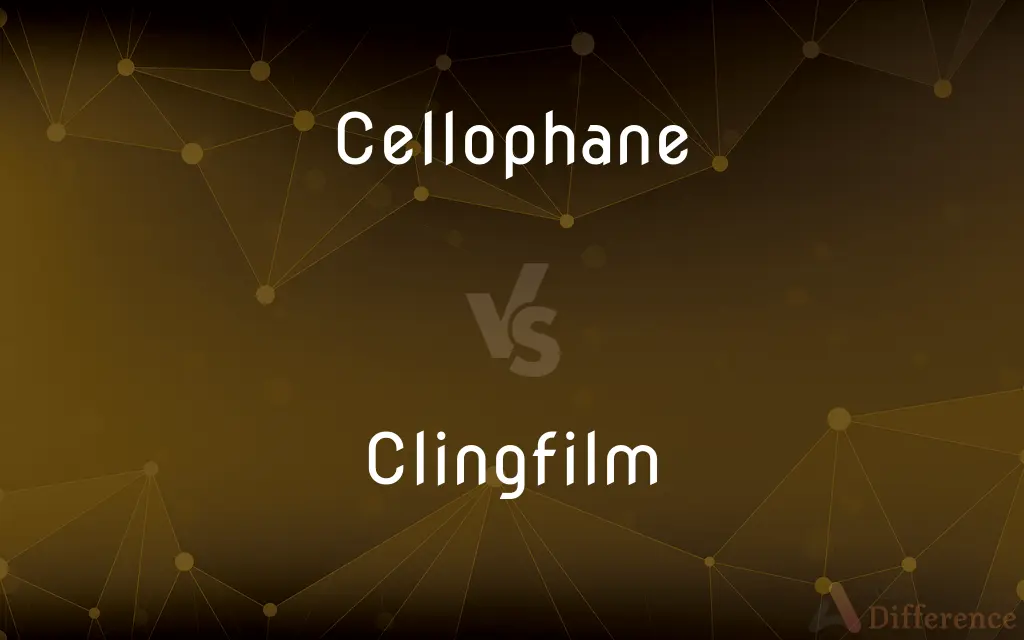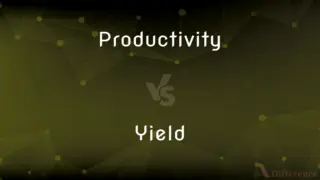Cellophane vs. Clingfilm — What's the Difference?
Edited by Tayyaba Rehman — By Urooj Arif — Updated on April 3, 2024
Cellophane is a biodegradable, transparent paper made from cellulose, offering a breathable yet protective layer; clingfilm, on the other hand, is a plastic film that clings to surfaces, providing a tight seal for food storage.

Difference Between Cellophane and Clingfilm
Table of Contents
ADVERTISEMENT
Key Differences
Cellophane, derived from natural cellulose, decomposes within months under the right conditions, making it an eco-friendly packaging option. Clingfilm, however, is made from various plastics like PVC or LDPE, which are not biodegradable and can take hundreds of years to break down. This fundamental difference in material composition highlights cellophane's environmental advantage over clingfilm.
Cellophane's breathability allows moisture to escape, which can prevent condensation and mold growth on food products like cheese and vegetables. Clingfilm, due to its plastic nature, creates a more airtight seal, which is better suited for keeping food moist and fresh longer, but may promote quicker spoilage due to trapped humidity.
In terms of visual clarity, cellophane tends to have a more glass-like appearance, providing a clearer view of the packaged product. Clingfilm, while also transparent, can sometimes have a slight haze, depending on its composition, which may slightly obscure the view of the item it wraps.
Cellophane's production process is more labor and resource-intensive, reflecting in its higher cost compared to clingfilm. Clingfilm, being plastic-based, is generally cheaper to produce and purchase, making it a more cost-effective choice for everyday use in households.
Despite cellophane's biodegradability, its use has declined in favor of clingfilm, primarily due to the latter's superior flexibility and clinginess, which make it more convenient for wrapping a variety of shapes and items tightly.
ADVERTISEMENT
Comparison Chart
Material Composition
Natural cellulose
PVC, LDPE, or other plastics
Biodegradability
Biodegradable (decomposes within months)
Not biodegradable (can take hundreds of years)
Breathability
Breathable (allows moisture to escape)
Non-breathable (traps moisture)
Transparency
Glass-like clarity
Transparent with possible slight haze
Cost
Generally more expensive
Cheaper to produce and buy
Compare with Definitions
Cellophane
A thin, transparent sheet made from cellulose.
She wrapped the gift in cellophane to keep it dry.
Clingfilm
Often used for sealing food items to keep them fresh.
He used clingfilm to wrap the sandwich tightly.
Cellophane
Allows moisture to escape, preventing condensation.
Cellophane is preferred for wrapping cheese due to its breathability.
Clingfilm
Made from various types of plastics like PVC or LDPE.
This brand of clingfilm is free from PVC for safety.
Cellophane
Biodegradable and eco-friendly packaging material.
They chose cellophane bags to reduce plastic waste.
Clingfilm
A thin plastic film that sticks to surfaces without adhesives.
She covered the leftovers with clingfilm before refrigerating.
Cellophane
Has a glossy, clear appearance.
The cellophane wrapping made the chocolates look even more tempting.
Clingfilm
Creates an airtight seal around containers and food.
Clingfilm keeps the food moist by trapping humidity.
Cellophane
Used for packaging foods, gifts, and other items.
The bakery uses cellophane to wrap its cookies.
Clingfilm
More affordable and flexible than cellophane.
They bought a roll of clingfilm for everyday kitchen use.
Cellophane
Cellophane is a thin, transparent sheet made of regenerated cellulose. Its low permeability to air, oils, greases, bacteria, and water makes it useful for food packaging.
Clingfilm
(British, Ireland) Light, transparent plastic film used as a wrapping for food etc.
Cellophane
A thin transparent wrapping material made from viscose
A cellophane bag
Clingfilm
A thin plastic film made of saran (trade name Saran Wrap) that sticks to itself; used for wrapping food
Cellophane
A thin, flexible, transparent cellulose material made from wood pulp and used as a moistureproof wrapping.
Cellophane
Plastic wrap.
Cellophane
Any of a variety of transparent plastic films, especially one made of processed cellulose.
Cellophane
(transitive) To wrap or package in cellophane.
Cellophane
A transparent paper-like product made of regenerated cellulose, produced in sheets and rolls, which is impervious to moisture and germs, and which is used to wrap candy, cigarettes, and a wide variety of other products for distribution and retail sale; as, a pack of cigarettes in a cellophane wrapper.
Cellophane
A transparent paper-like product that is impervious to moisture and used to wrap candy or cigarettes etc.
Common Curiosities
Is cellophane better for the environment than clingfilm?
Yes, cellophane is biodegradable and considered more eco-friendly than clingfilm.
What is cellophane made from?
Cellophane is made from cellulose, derived from plants.
Why is clingfilm popular in kitchens?
Clingfilm is popular due to its affordability, flexibility, and ability to create airtight seals.
Is clingfilm biodegradable?
No, clingfilm is not biodegradable and can take hundreds of years to decompose.
Can cellophane be used in the microwave?
It's not recommended to use cellophane in the microwave as it can melt or catch fire.
Can clingfilm be recycled?
Clingfilm generally cannot be recycled through conventional municipal recycling programs.
Why is cellophane more expensive than clingfilm?
The production of cellophane is more resource and labor-intensive, making it more expensive.
How does clingfilm keep food fresh?
Clingfilm keeps food fresh by creating an airtight seal that traps moisture and prevents air exposure.
How long does it take for cellophane to degrade?
Cellophane can degrade within a few months in a composting environment.
What are the main uses of cellophane?
Cellophane is used for wrapping food, gifts, and other items, offering a protective yet breathable layer.
Can I compost cellophane?
Yes, cellophane can be composted as it is biodegradable.
Can clingfilm be used in the freezer?
Yes, clingfilm can be used in the freezer to protect food from freezer burn.
What types of food are best wrapped in cellophane?
Foods that benefit from breathability, like cheese and some vegetables, are best wrapped in cellophane.
Does clingfilm have any health risks?
Some concerns exist about chemicals leaching from certain types of clingfilm into food, especially when heated.
What makes clingfilm cling to surfaces?
Clingfilm is made from plastics that have a natural stickiness, allowing it to cling to smooth surfaces without adhesives.
Share Your Discovery

Previous Comparison
Productivity vs. Yield
Next Comparison
Shuttlecock vs. BadmintonAuthor Spotlight
Written by
Urooj ArifUrooj is a skilled content writer at Ask Difference, known for her exceptional ability to simplify complex topics into engaging and informative content. With a passion for research and a flair for clear, concise writing, she consistently delivers articles that resonate with our diverse audience.
Edited by
Tayyaba RehmanTayyaba Rehman is a distinguished writer, currently serving as a primary contributor to askdifference.com. As a researcher in semantics and etymology, Tayyaba's passion for the complexity of languages and their distinctions has found a perfect home on the platform. Tayyaba delves into the intricacies of language, distinguishing between commonly confused words and phrases, thereby providing clarity for readers worldwide.














































